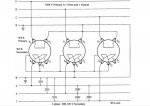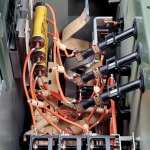electrofelon
Senior Member
- Location
- Cherry Valley NY, Seattle, WA
This is one of those things that comes up and I am baffled I have never thought about this before. To make a wye three phase bank you need 120v transformers. Seems inefficient to use the center tap of a standard 120/240 transformer, you are paying for a lot of transformer that you are not using. Granted that reduces your inventory. Is this pretty much always how its done? This is how Seattle City Light does it. See figure 3.1d and 4.
http://www.seattle.gov/light/engstd/docs2/0125.03.pdf
So when connected in this manner, the total system KVA is half the sum of the nameplates of the three individual units?
http://www.seattle.gov/light/engstd/docs2/0125.03.pdf
So when connected in this manner, the total system KVA is half the sum of the nameplates of the three individual units?


